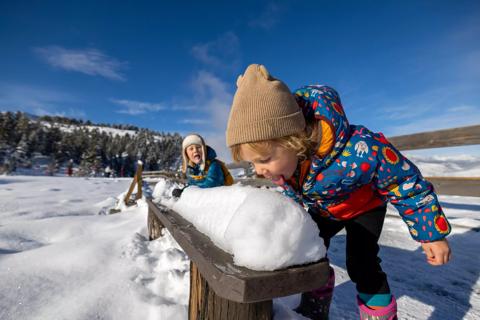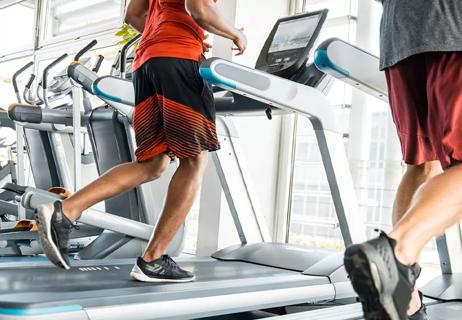From shoes to staying hydrated in sub-freezing temperatures

For many runners, winter’s arrival doesn’t keep them from hitting the road. No matter how cold or how much snow is on the ground, these die-hard runners still lace up their shoes to get in a workout.
Cleveland Clinic is a non-profit academic medical center. Advertising on our site helps support our mission. We do not endorse non-Cleveland Clinic products or services. Policy
While running in cold weather has a lot of overlap with running in warm weather, it also has its share of unique challenges to be aware of. From stretches to gear to temperature safety limits, there’s a lot to keep in mind.
Whether it’s a new healthy habit or you’re a veteran of jogging icy streets, it’s important to know how to best approach these cold-weather workouts. To get the best tips for keeping your running routine going during the winter, we talked to sports medicine physician Caitlin Lewis, MD.
Wearing the correct running gear is something that seems easy. But, in reality, there are a lot of things to keep in mind for when you’re running in cold temperatures. “Using the right gear is huge for running outdoors during winter,” says Dr. Lewis.
In the summer, you’re basically focused on staying cool. But during the winter, you have to strike the right balance: Don’t overdress yourself to the point of overheating, but don’t underdress yourself to the point of not staying warm enough.
It can be a challenge, especially if you’re new to this, but Dr. Lewis walks us through the best way to dress for cold-weather running success.
Layering is important because you can dress for warmth at the start of your run when you’re feeling cold, but then allows you to strip down later in your run when your blood is flowing and your body temperature is rising. And it all starts with the base layer.
“Using moisture-wicking fabric at the base layer is super important,” Dr. Lewis says. “It moves the sweat away from your skin. You might not think you’ll sweat during a cold run, but that’s a misconception. It might not be as much sweat as a summer run but there will be some moisture.”
And that moisture, she says, is meant to remove heat from your body, allowing it to cool. If you’re wearing something like a long-sleeve cotton t-shirt and that moisture isn’t moved away from the skin, you’ll actually get colder as the moisture just sits there.
What additional layers you need depends on the weather you’re anticipating during your run.
“The general rule for running outside is to dress for conditions 15-20 degrees warmer than what the temperature actually is,” Dr. Lewis advises. “You’ll feel a little bit cold in the beginning but as your body temperature rises during the workout, it will keep you from having to remove too many layers during the run.”
Just be sure that whatever removable layers you have are easy to take off and tie around your waist or store while you run. Otherwise, you might be burdened with awkwardly hauling a large sweatshirt for a few miles to get back home.
Make sure your layers are all highly visible or reflective. While each runner has their own preference for what time of day works best for them, the shortened hours of daylight increase the odds of you running in the dark, either early in the morning or in the evening. You might have plenty of sunshine after work for an evening run in July, but the skies get pretty dark early on in January.
“It’s best to make sure all your layers are highly visible – bright colors – or reflective,” Dr. Lewis points out. “And if you’re layering, make sure your outer layer is reflective and visible. Don’t wear a reflective shirt and then throw on a non-reflective jacket or hoodie over it.”
If you’ve got a good stash of running clothes but nothing is visible, your local sporting goods store will have a variety of lightweight reflective vests that can be worn on top.
“There are even headlamps that you can buy to wear while you run in the dark,” Dr. Lewis notes. These lamps not only alert others to your presence, but can also safely shed light in front of you so you have a better awareness of any obstacles in front of you, like cracked sidewalks.
Keeping your head covered is another essential task during winter running. “The idea you lose all this heat from your head is a misconception,” Dr. Lewis says. “But you do sweat from your head and you want to keep that moisture away from your scalp to keep your head warm so a hat certainly helps.”
As with other gear, there are hats specifically made with moisture-wicking material to keep your head as dry as possible, a more comfortable experience than running several miles with a wool hat on that could lead to excess heat and excess sweating.
Those winter hats are also important in covering the parts of your head that are exposed, like your ears. They not only keep moisture away but they protect those parts from frostbite.
The same goes for wearing gloves. Whether your find gloves or mittens more comfortable is really up to you, she adds, just as long as your keeping your hands and fingers covered.
Before they became a go-to accessory during the COVID-19 pandemic, neck gaiters were (and still are) routinely used by cold-weather runners for keeping heads and necks warm. Some are designed to cover the mouth, too.
You’ll want to be careful, Dr. Lewis says, of making sure these stay dry, too, and keep them from getting frozen in very low temperatures. Ones made of fabric are more likely to face this issue than ones made of moisture-wicking material.
If your sidewalks or running trails and tracks are free and clear of ice and snow, your typical running shoe is just fine. There’s no reason to switch things up just because it’s cold outside. Just be sure you’ve got the right running shoe for your body and gait in the first place.
But if there’s ice along the way and you’re focused on getting those miles in, things can get a bit more complicated. There are some cleats or even grips you can slip over your shoes that are made specifically for walking and running through these kinds of conditions.
Just because you’re wearing them, though, doesn’t mean you won’t slip and injure yourself on a slick patch. Plus, these grips can make for an awkward experience as you switch between snow and ice patches and plain concrete sidewalks numerous times during a run.
One final note when it comes to your gear when you’re finished: don’t dawdle, says Dr. Lewis. Whether you take a shower or just change into drier clothes, it’s important to take your moisture-laden running gear off as soon as you’re home.
“When you’ve finished your workout, your metabolic rate is going to drop pretty quickly and your ability to produce heat is also going to drop,” she says. “So if you’re still sitting around in your cold, wet clothes, you’re still at risk for hypothermia even though you’re done running and inside.
When it comes to stretching, Dr. Lewis recommends dynamic stretching over static stretching. Dynamic stretching involves using sports-specific motions to actively move joints and muscles, typically mimicking the activity you’re about to do. Static stretching, conversely, is about moving a joint as far as you can stretch and then holding the position for 30-to-90 seconds
Besides getting muscles better coordinated, dynamic stretching also improves blood flow to the targeted muscle groups which increases muscle temperature and flexibility. “Once you get outside and the cold air hits your muscles, they’ll tense up and decrease the blood flow,” says Dr. Lewis.
To that end, she also recommends you do your dynamic stretching inside, not outside. “By starting off with your stretching in a warm environment will do a better job getting your muscles warm and your blood flowing than would happen if you were stretching outside,” she says.
There are plenty of other things to be aware of when you’re running in cold weather, too, things to improve your safety and your health.
We typically worry more about staying hydrated during warm-weather exercise. After all, if it’s cold, you’re not sweating as much, right? Not quite, says Dr. Lewis. She says that hydration is still essential. “You actually have to be a little more cognizant of staying hydrated in cold weather because you’re still sweating but you’re not feeling as thirsty,” she points out.
Additionally, while gulps of ice-cold water are refreshing during hot runs, they’re less desirable on cold runs. “That ice-cold water will bring your body temperature down quickly in super cold conditions,” she says. “It doesn’t have to be warm water but try to use room-temperature water. If you have a small water bottle, consider keeping it within your layers, closer to your body, to keep it a bit warmer.”
Again, make sure you’re running path is clear. Snow and ice greatly increase the risk of slips and falls which means injuries. As for running in the street to avoid treacherous sidewalks, well, that might seem like a good idea on quiet residential streets, but it’s still running in the street and that should always be avoided for obvious safety reasons.
As for trails, make sure those are clear, too, because the same slip concerns of snow and ice remain. Also, trails are more likely to experiencing pooling of melted snow and ice and if you’re not equipped with waterproof shoes, that means cold and wet feet which can lead to a host of problems, from frostbite to blisters.
It might be a disappointment for the day, but if your path isn’t safely clear, it’s best to wait a day or two for things to melt.
How cold is too cold to run is a matter of perspective. Some people won’t head outside for anything below freezing. Others are good to go as long as temperatures are above zero. It just varies from person to person
Whatever you decide, though, remember to dress appropriately and consider either shortening your distance or doing loops, says Dr. Lewis. This way you’re never too far from home in case the weather deteriorates or you find yourself getting too cold on the run.
Finally, it’s important to keep things in perspective when running during the winter. “Most people aren’t going to make huge gains in winter,” Dr. Lewis says. “Running is more about maintaining a healthy lifestyle and getting exercise than it is about setting personal records or running longer distances than normal.”
“Be realistic,” she adds. “Any run is a good run. It’s still good exercise and not every run, especially in more extreme weather, has to be life-changing. Be kind to yourself and just be smart and safe.”
Learn more about our editorial process.

Sea lice aren’t really lice, but these tiny creatures can trigger an unpleasant allergic reaction

Stretch before heading outside, keep proper form and avoid jerking or twisting to throw snow

A distressed skin barrier can lead to red, itchy and scaly skin

If the flakes are undisturbed, pristine white and come from the top layer, it’s typically safe to indulge in a scoop

A type of high-intensity interval training, fitness boxing can challenge your body and mind

Running doesn’t cause knee arthritis, but you can take steps to minimize cartilage damage

With a little precaution, you can prevent injuries and stay in this good-for-you game

Your metabolism may torch 1,300 to 2,000 calories daily with no activity

A gentle touch in all the right places may help drain your sinuses